WEDNESDAY
JANUARY 16 - 2013
BROOK
MEADOW
Firecrest
still here
I met Malcolm Phillips
at about 10.30 this morning, who told me he had just
had yet another sighting of 'the' Firecrest close to
the south bridge. I made my way to the south bridge
and was lucky to get my first, albeit somewhat
fleeting, sighting of the Firecrest beneath the south
bridge before it flew off up the flooded path from the
south bridge. Malcolm e-mailed me later to say he had
some good views of the Firecrest at the S-bend which
is where 'my bird' must have been heading. Malcolm
returned to Brook Meadow after his trip onto Thorney
Island and saw the Firecrest yet again, this time by
the observation fence. I really must stay with Malcolm
in future!
Here
is just one of Malcolm's many photos of this smashing
bird
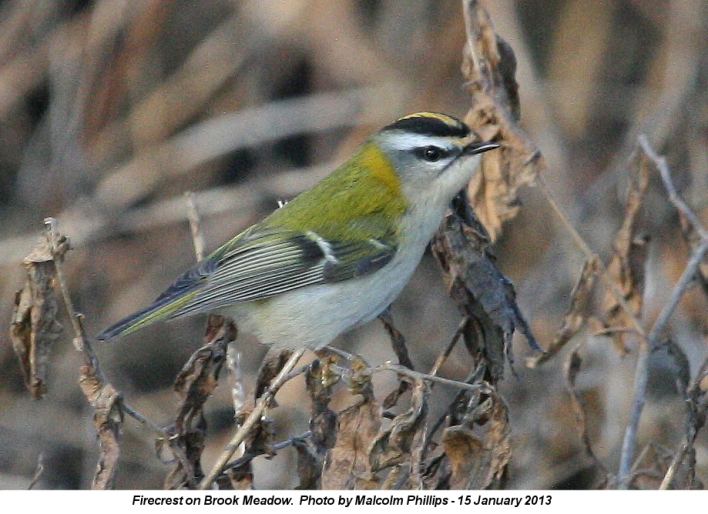
Other
birds
Malcolm also reported
seeing several Wrens on the river bank and a Goldcrest
near the north bridge as a nice comparison with the
Firecrest.
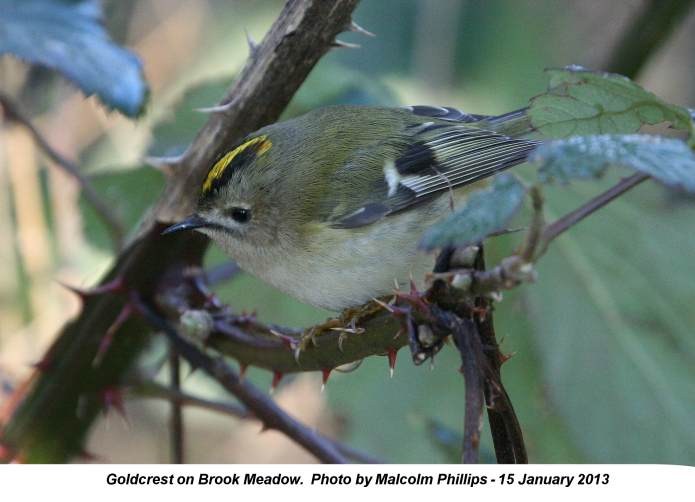
Water
Voles
Yesterday, Maurice
Lillie saw a Water Vole near the S-bend and today saw
what was probably the same animal in much the same
place. Malcolm Phillips also saw a Water Vole today
swimming in the river near the observation fence.
These three take the total sightings for 2013 to
seven.
Here
is Malcom's photo from today
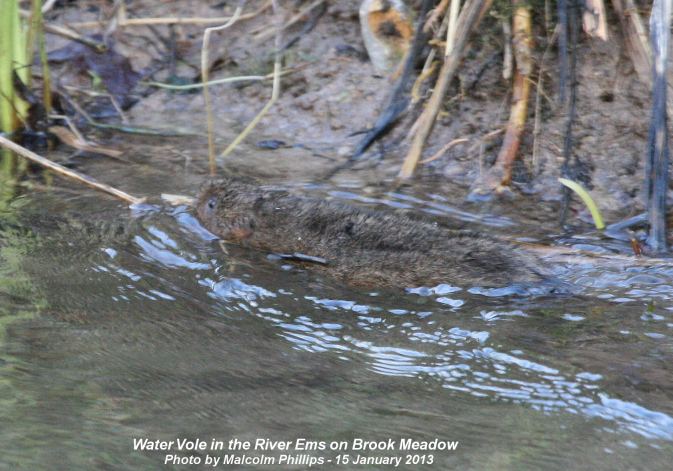
MALCOLM'S
OTHER PHOTOS
Fox
on Thorney
From Brook Meadow
Malcolm Phillips went down to Thorney Island where he
got this photo of a very healthy-looking Fox basking
in the sunshine.
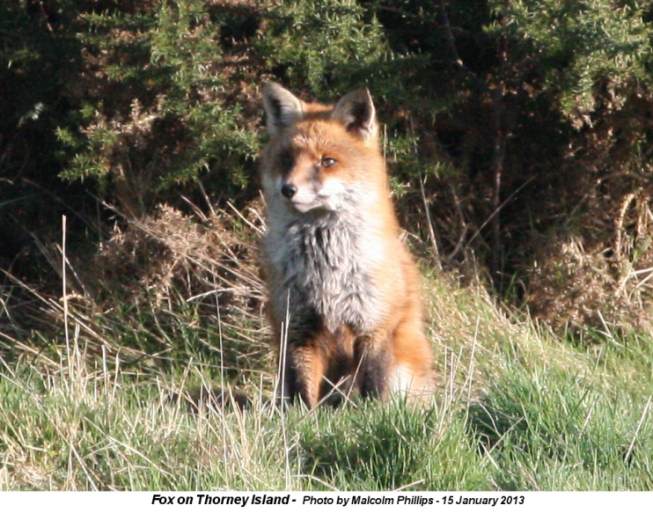
Pied
Wagtail
As he passed by
Slipper Millpond, Malcolm saw this Pied Wagtail
sitting on the door handle of what I am fairly sure is
Brendan Gibb-Gray's house in Chequers Quay. I recall
Brendan telling me about this bird which taps on his
French doors for food.
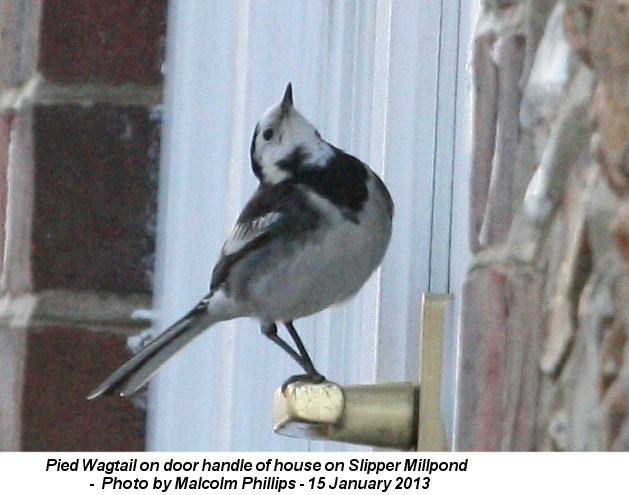
EMSWORTH
HARBOUR
I went round Emsworth
Harbour on a rising tide, starting at the millpond and
finishing at Nore Barn.
Black-tailed
Godwits
I am pleased to report
that a few Black-tailed Godwits are back in the
harbour after an absence of a some weeks. I found six
Black-tailed Godwits on the edge of the main channel
in the eastern harbour and another 14 at Nore Barn.
The latter group included one colour-ringed bird:
ROL+RLR. This is a Kent-ringed godwit which has been a
regular in Emsworth this winter.
Here
is a photo of this bird taken in Nov 2010
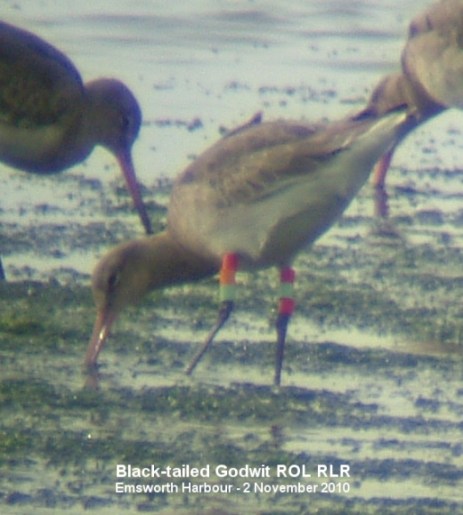
Spurting
I watched the 14
Black-tailed Godwits feeding in shallow water at Nore
Barn as the tide came in and clearly noticed some
examples of 'spurting'. Interestingly, I noticed one
bird in particular that appeared to be washing out its
beak in the manner suggested by Tom Bickerton in last
night's entry. It inserted its bill just below the
surface of the water and not deep enough for feeding,
then withdrew it and spurted water. Unfortunately I
did not get a photo of this.
Here
is a photo I took earlier in the year

Two
Spotted Redshanks
At about 12:30 two
Spotted Redshanks were feeding in the stream at Nore
Barn. They were not actually feeding together as one
of the birds (the 'resident') chased off the other one
if it came too close. Finally, I had a magical
experience as I stood on the shingle at the end of
Warblington Road watching the resident Spotted
Redshank feeding close to the shore. I remained
completely still as the bird walked along the shore
towards where I was standing. I was taking photos of
it as it came, until it was almost right beneath me,
too close for my zoom! I got probably my best ever
photos of this astonishing bird.
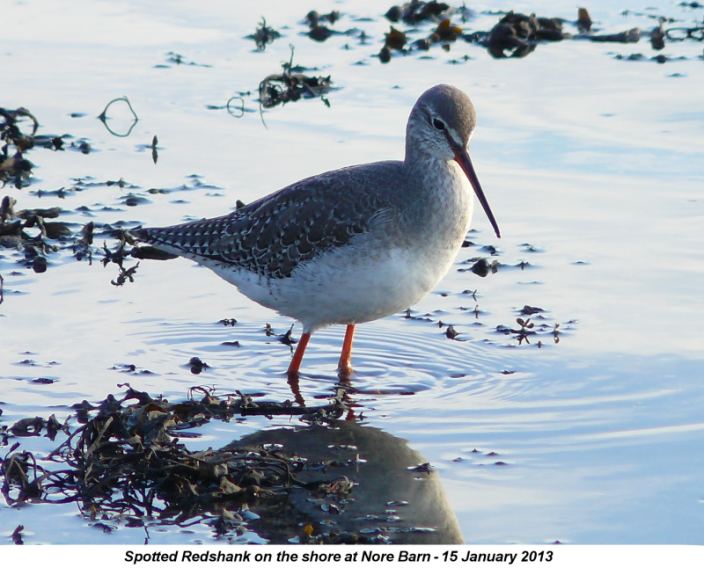
Other
birds
There were very few
Brent Geese in the harbour, not more than 20 in
all. I think they must be feeding on inland fields as
they have done in previous years. However, there were
good numbers of Wigeon and Teal in the
Nore Barn area, which have also been quite low
recently. Also, I counted 41 Shelduck and 10
Pintail on the western mudflats.
Winter
insects
I noticed a few
Bluebottle flies on what remains of the flowers on the
large Ivy hedge at the end of Warblington Road at Nore
Barn.
BTO
NEWS
More
Coal Tits visiting gardens
Earlier this winter,
BTO Garden BirdWatch scheme revealed that Coal Tits
were reported in nearly 75% of gardens which is far
more than usual. Patchy natural seed production in
2012 and last autumn's wet weather are the likely
reasons for the increase. Rain causes the cones of
conifers to close, making the seeds they hold
inaccessible to Coal Tits. . . . http://bto-enews.org/NXN-17ZF5-3GJW16-HJTHW-0/c.aspx
TUESDAY
JANUARY 15 - 2013
BROOK
MEADOW
Yet
another Firecrest
Malcolm Phillips had
yet another sighting of a Firecrest on Brook Meadow
this morning. This one was from the observation fence
overlooking the river in Palmer's Road Copse. The
Firecrest came right in front of him which meant he
could get more excellent photos of this normally
elusive bird. Here is one of Malcolm's photos, showing
a male bird unusually with its orange crest raised. I
gather it only does this when excited, which it must
have been seeing Malcolm yet again with his camera
pointing at him!
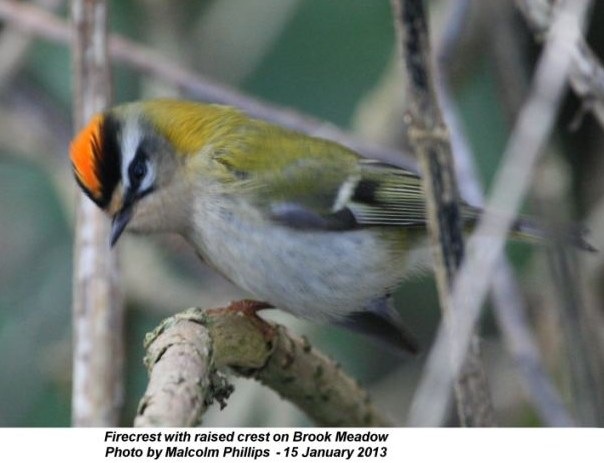
Malcolm returned to
Brook Meadow After lunch and saw the Firecrest again,
this about 50 yards further south, close to where he
saw it yesterday near the south bridge.
Brian Lawrence also
saw a Firecrest today on Brook Meadow, but this one
was at the other end of the meadow at the side of the
north bridge, close to where Malcolm had his first
Firecrest sighting on Jan 3. Brian's photo also shows
the orange crest of a male, so it could have been the
same bird that Malcolm saw.
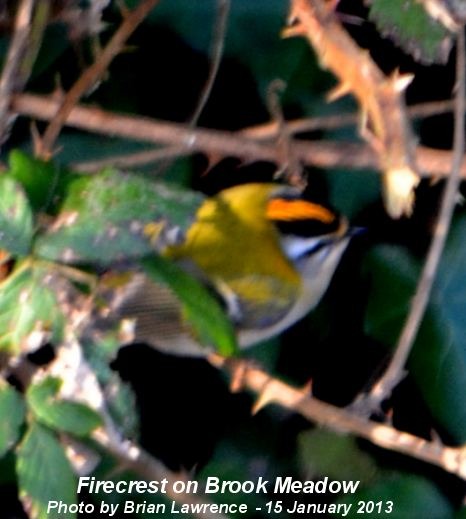
Nuthatch
I had a short walk
through Brook Meadow late this afternoon. A Nuthatch
revealed itself to me by calling very loudly from one
of the tall Crack Willows on the north path. I managed
to locate it climbing swiftly around on the tree
trunks, but could only get a rather distant photo.
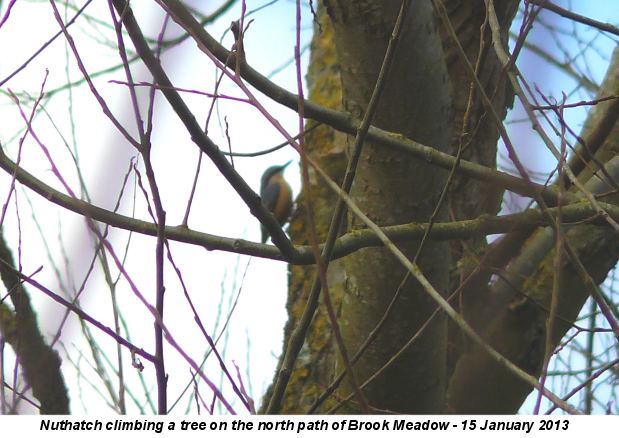
Bird
song
I heard one short
burst of song from a Wren; this was the first Wren
song I have heard for quite a while. Great Tits were
in particularly good voice on this morning with
several singing around the meadow.
Water
Vole
Walking through
Palmer's Road Copse at about 3pm, I spotted a Water
Vole basking in the late afternoon sunshine on the
east bank of the river, opposite the Deep water sign.
This is our first sighting in this area of the river
since 20 Oct 2012.
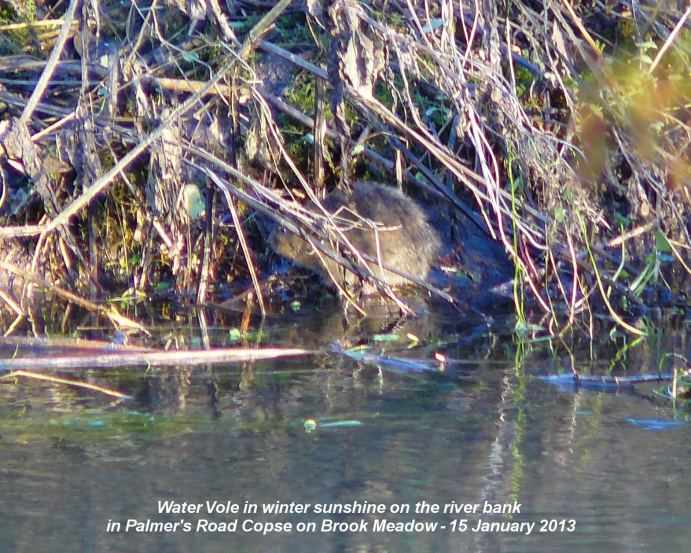
NORE
BARN
Richard Hallett was at
Nore Barn this morning. He found "A nice little group
on the rising tide at 11.30. This consisted of two
Spotted Redshanks together with a Common Redshank and
a Greenshank. One Spotted Redshank and the Common
Redshank went off together along the shore towards the
West . Legs were well covered and for a time they were
swimming so I was unable to see rings. The other
Spotted Redshank and the Greenshank carried on up the
stream towards the bridge as the tide rose
further."
Peter Milinets-Raby
and John Norton did a long circular walk around the
Warblington area this morning, starting at Nore Barn,
walking along the coast, cutting inland along Pook
Lane then coming back across the fields passed
Warblington Church. They also saw 2 Spotted Redshank
and a Greenshank at Nore Barn (around 1pm), Here is
one of the Spotted Redshanks.
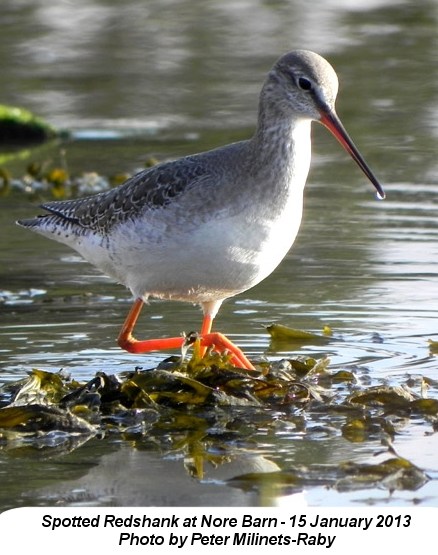
Other birtds seen on
their walk included, Reed Bunting, 7 Little Egrets
feeding in the fields off Pook Lane, Rock Pipit, 7 to
12 Stock Doves, 5 Curlew feeding in the fields north
of the church, 54 Brent Geese feeding on fields away
from the coast, 15 Song Thrush together with 20+
Blackbirds feeding at a field edge off the main A259
Emsworth Road.
WINTER
FLOWERS
More white blossom has
opened in the past few days on the Cherry Plum tree on
the causeway of Brook Meadow. Five new flowering
plants for the January list today were Knotgrass,
Sticky Mouse-ear, Thyme-leaved Speedwell and Field
Forget-me-not, all on the roadside verge on New
Brighton Road outside the gate onto the Railway
Wayside, plus Wood Avens on the Lillywhite's path
wayside. This takes my personal list to 28 species.
GODWIT
SPURTING
Regarding the spurting
behaviour in Black-tailed Godwits (see yesterday's
entry) Tom Bickerton writes: "I think it's mouth
rinsing, when they eat the Godwits not only take in
the food item, but salt, grit and detritus. They can't
manipulate the tongue around as we do, so they take in
fresh water and force the bits out, therefore cleaning
the inner mandibles. It can't be that pleasant or
healthy to have grit within your bill."
PEREGRINE
HUNTING
Tom adds this note for
anyone who wants to watch Peregrines hunting: "The
Oysterbeds are particularly good at the moment, with 3
different birds giving us a 2 hour show on Sunday.
There is a resident male juvenile there at present
with both adults putting in a spectacular attack. Best
time would be a morning high tide about 1.5- 2 hours
before, as the waders start to roost, clear sunny
conditions, not much wind and just wait for them, the
juvenile does like perching on the outer bung. He's
not that successful at the moment, but highly
entertaining."
MONDAY
JANUARY 14 - 2013
LOCAL
NEWS
Firecrest
again
Malcolm Phillips got
round Brook Meadow this morning before the rain and
got another good sighting of what maybe the same
Firecrest that has been seen twice before on the
meadow, but all the sightings were in different
locations. Today, Malcolm saw it in Palmer's Road
Copse near the south bridge, the patch between the
river and the flooded path.
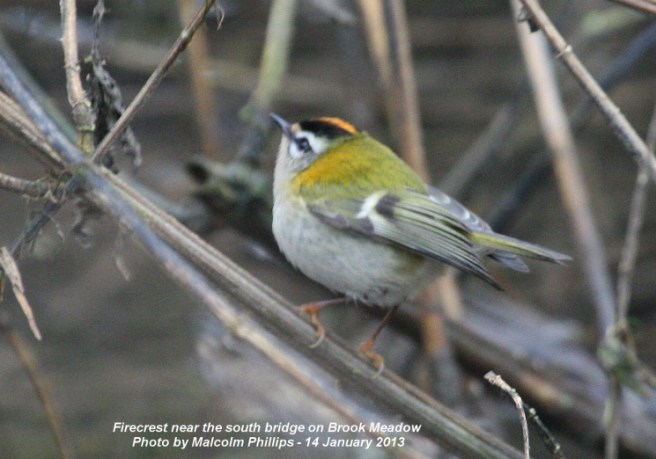
Garden
Goldcrest
I had a yet another
Goldcrest in my garden near the centre of Emsworth
today. This was the 4th week running I have recorded
this bird, which previously has been a very rare
visitor. Here is my photo through the window in light
rain. Nice to compare with Malcolm's Firecrest above
ie no white supercilium on the Goldcrest.
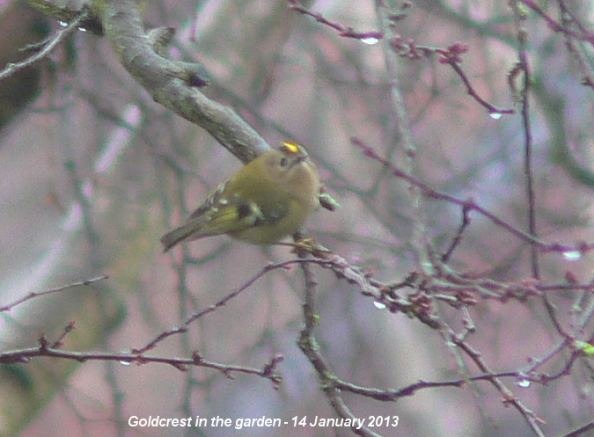
Just a
quick shot of the snow falling on my garden this
morning. It did not last.

Other
bird news
Brendan Gibb-Gray
e-mailed to say they have a Kingfisher
regularly fishing again on Dolphin Quay near his
house. Kingfishers seem to be a bit scarce this
winter. I have yet to see one.
Susan Kelly saw a
group of at least 5 Little Grebes feeding
around the boats in the harbour on a very wet Saturday
morning (Jan 12).
Winter
flowers
Hazel catkins are now
open for the first time this winter on the east side
of the north meadow of Brook Meadow.
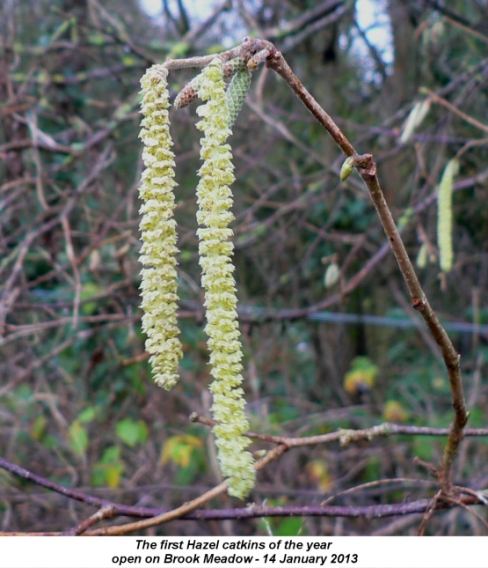
There is a fine
display of Winter Heliotrope on the roadside
embankment in the centre of Emsworth near the Emsworth
Surgery.

Red-breasted
Goose on Thorney
Today, Barry and
Margaret Collins found a Red-breasted Goose feeding
amongst ca. 1000 Dark-bellied Brent Geese at Thorney
Island airfield. This could be the bird that has been
on Farlington Marshes for several weeks. They also
enjoyed a superb adult male Marsh Harrier quartering
the reed bed at the Little Deeps late afternoon.
Missing
Godwits
During a WeBS count,
Peter Hughes counted 590 Black-Tailed Godwits split
more or less evenly between the Pulborough and
Amberley Brooks. That is probably where some of the
missing godwits from Emsworth Harbour have gone.
Others are no doubt at Pagham Harbour where over 1,000
have been reported recently.
Good
stuff at Arundel WWT
Harry Ramm had some
cracking sightings at Arundel WWT Reserve today,
including a Bittern that landed right in front of the
Scrape Hide. He also had a Cetti's Warbler and two
Water Rails from the same hide plus two Snipe and two
Kingfishers. From the Sand Martin Hide there were at
least four Kingfishers at one time and four
Bullfinches, plus an Egyptian goose on Swanbourne
Lake. Worth a visit!
Spurting
behaviour
I have just submitted
a short paper to the Wader Study Group Bulletin, at
the request of The Editor, about some unusual
behaviour that I and others have observed in
Black-tailed Godwits and certain other waders, in
which water and other objects are actively spurted
from their bills during feeding in shallow water.
Our photos of this
spurting behaviour have been seen by several wader
experts, but no one seems to know anything about it,
which I find surprising considering how common it
appears to be at least in Emsworth Harbour. You can
see photos of the behaviour on a special 'spurting'
web page at . . . Spurting
behaviour
I have also put a
short digiscoped video of some Godwits feeding and
spurting at Nore Barn in Jan 2012 on YouTube. The link
is at . . . http://youtu.be/uHXSH9jzh94
SUNDAY
JANUARY 13 - 2013
EMSWORTH
Jean and I walked
through Brook Meadow on our way for coffee in the Deck
Cafe in Emsworth Marina on a bright but very chilly
morning.
Brook
Meadow
We had a quick look
along the river bank north of the north bridge, but
there was no sign of the Water Vole that has been seen
here in the past two weeks. The buds of
Butterbur are now poking up out of the ground on
the edge of the river path near the sluice gate. Soon
they will be showing their pink flower spikes which
always emerge in early spring. A pair of Great Tits
were busy in the bushes alongside the causeway. We
stood for a few minutes on the Lumley Path bridge at
the north end of Peter Pond, but there was no sign of
the Firecrest which Malcolm Phillips saw here on Jan
11.
First
blossom
We noted the first
flower blossom, just one was open, on the Cherry Plum
tree on the causeway across Brook Meadow, which Roger
Mills spotted a couple of days ago. This is the tree
that the conservation group chopped down about 12
years ago and which has now regrown to an impressive
bushy tree. It produces a white blossom which smells
very good. I am told that it is a purple-leaved
cultivar Pissardii, commonly grown in suburban
gardens.
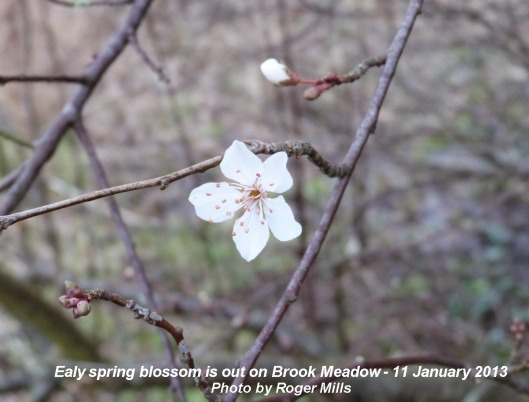
Slipper
Millpond
What I am sure is the
pair of Great Black-backed Gulls that nested
here last spring was back on the pond, no doubt
staking out their territory, though there is no
competition apart from the resident Coots.
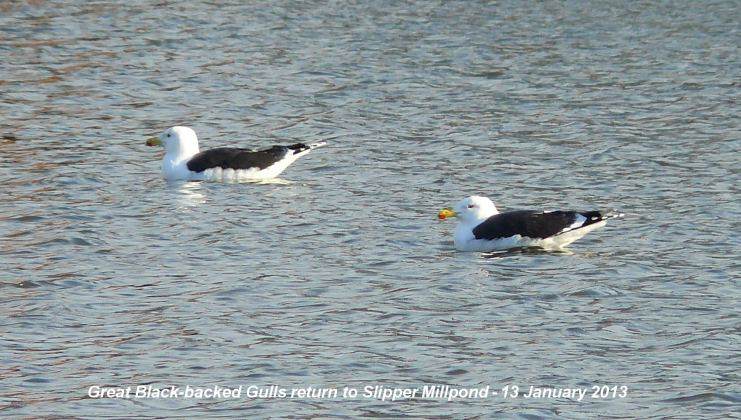
We watched a pair of
Cormorants fishing in the pond; one with a grey
head caught an Eel and finally swallowed it after
several minutes of thrashing around. A Little Grebe
was also fishing, though not for Eels!
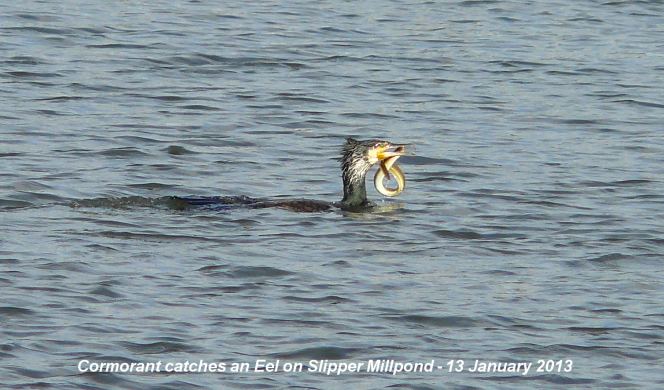
FINDHORN
NEWS
Richard Somerscocks
reports from his new home in Findhorn in Northern
Scotland with photos, including Great Northern Diver,
Shag with Long-tailed Duck swimming by and,
agonisingly for us southerners, no less than 19
Waxwings in his garden! See Richard's excellent photos
on the special Findhorn web page at . . .
Findhorn
News
GARDEN
BIRDS
Patrick Murphy had
some nice birds on his fat ball feeder on a very wet
Saturday (Jan 12). They included two male Blackcaps
and two Long-tailed Tits. Patrick says there is a male
Blackcap at the back of the feeder with the
Long-tailed Tits, though we will have to take his word
for it!
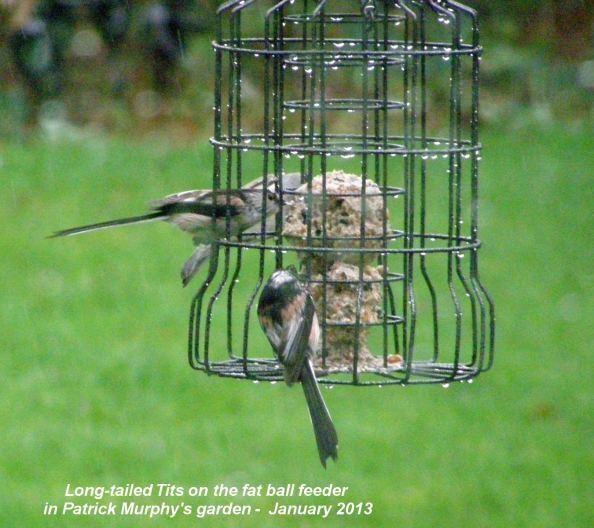
Graham Petrie already
has 19 species on his garden bird list for 2013. These
include a re-appearance of Coal Tits, regular visits
from Nuthatch, and now fairly regular visits from
Greenfinch, Chaffinch and up to 15 Goldfinch.
My own garden list is
now up to 14 so far for 2013, including the following
in good numbers: 14 Chaffinches, 10 Collared Doves, 6
Woodpigeons, 4 Goldfinches, 3 Magpies. We have also
seen a female Blackcap, a Goldcrest and notably a
House Sparrow!
OTHER
LOCAL NEWS
Spotted
Redshanks at Nore Barn
Brian Lawrence was at
Nore Barn on Thursday Jan 10) and got some cracking
pictures of the Spotted Redshank. Here is one Brian
sent me for the web site.
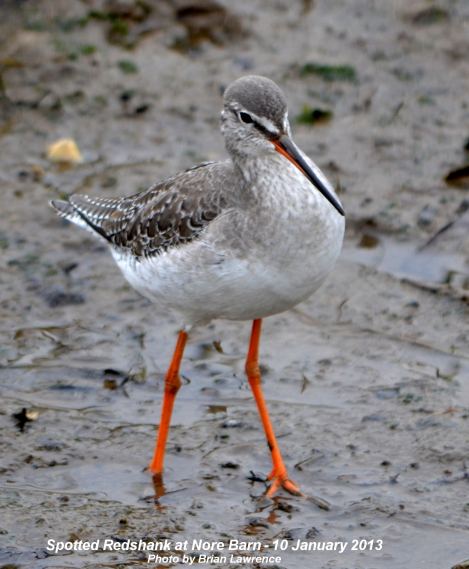
John Walton went to
Nore Barn this morning at about 09:30 where he found
two Spotted Redshanks feeding together in the stream.
A little further downstream the Greenshank was taking
a nap.
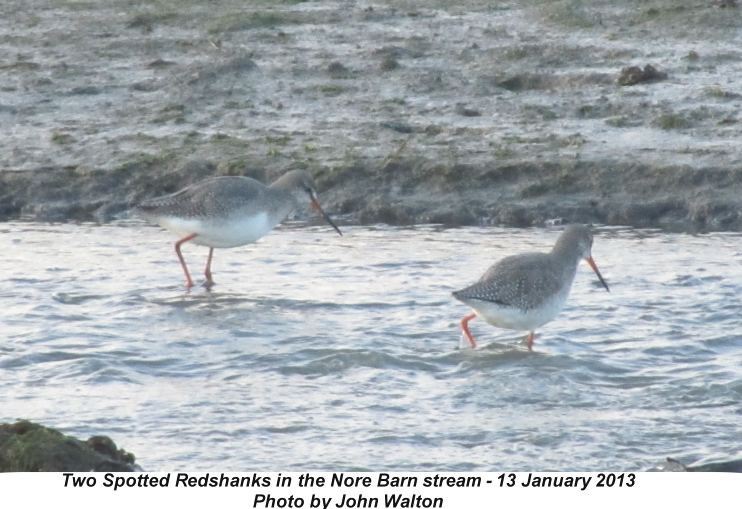
All
the Spotted Redshank news and photos is on the special
web page at . . .
Spotted
Redshanks
First
Siskin for Brook Meadow
Malcolm Phillips got
what I think was another first for Brook Meadow when
he saw and photographed a male Siskin feeding on the
Alder catkins near the Lumley Stream.
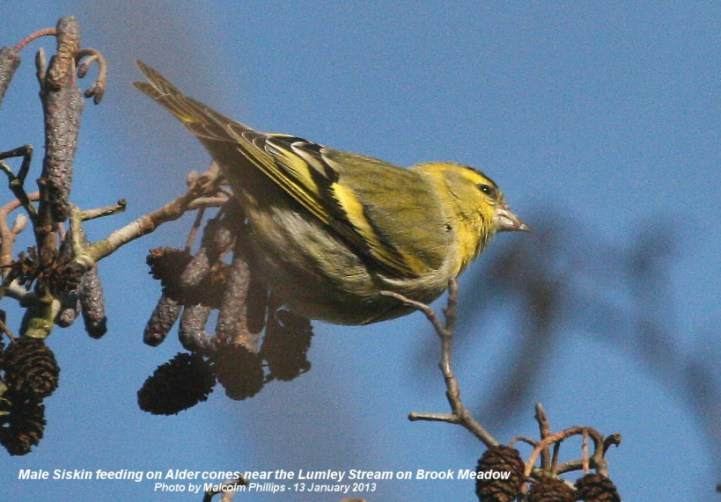
Partial
albino Blackbird
Terry and Paul Lifton
met up with Malcolm on the Lumley Path bridge where
the Firecrest was seen on Friday, and although they
stayed with Malcolm for well over an hour the bird did
not turn up. However, They did see the pair of
Siskins, a Treecreeper and a Goldcrest, along with
Robin, Long Tailed Tits, Blue Tits and Great Tits.,
They also saw and photographed the female Blackbird
with a white patch on its wing, which has been
frequently seen in the Lumley area for a couple of
years at least.

Dunlin
display
Tony and Hilary
Wootton walked down the Billy Line today and had a
wonderful display of the Dunlin at the oysterbeds
performing near to high tide. A Peregrine flew
straight for the Dunlin very low and quickly across
the water, before scattering the birds.
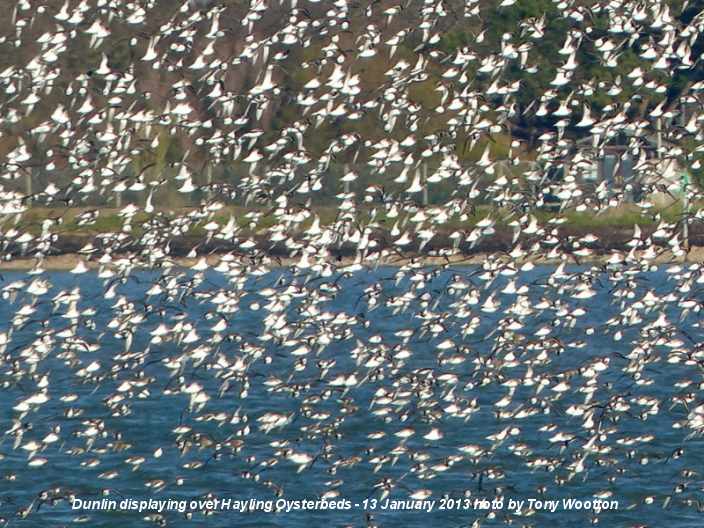
Kingfisher
Tony and Hilary also
had a good view of a Kingfisher flying across the
harbour near Nore Barn.
FRIDAY
JANUARY 11 - 2013
NORE
BARN
Two
Spotted Redshanks
I had just finished
delivering my usual batch of Brook Meadow Conservation
Group Newsletters in west Emsworth and it was such a
beautiful morning with bright sun and barely a breath
of wind that I decided to go down to Nore Barn to
drink my flask of coffee. It was 10.30 and the spring
tide was fully in. From the end of Warblington Road I
casually glanced over to the stream, now completely
full of water, with my binoculars and my great
surprise there was what looked like a pair of Spotted
Redshanks roosting on the edge of the saltmarshes on
the west side of the stream. I have never before seen
two Spotted Redshanks roosting there at high water
before.

To make absolutely
sure, I rushed back home for my scope and confirmed
the sighting. Although I could not be certain the
Spotted Redshank on right appeared to have rings on
its legs and, if so, was W+GY which I have only seen
at Nore Barn once before on 27-Oct-12.
While I was there I
had the company of Wally and Rosemary Osborne for
coffee on the sea at the end of Warblington Road. And
Anne de Potier arrived just as I confirmed the
presence of the two Spotted Redshanks.
Ros Norton e-mailed me
this evening to say she was at Nore Barn about 2 hours
after me and saw a Spotted Redshank fly into the
stream at 12:46. Ros watched it feeding alone for half
an hour. So, presumably the second bird had gone.
BROOK
MEADOW
Water
Vole
I was pleased to get
my personal first Water Vole sighting of 2013 this
morning at about 12 noon. It was on the west bank of
the river north of the north bridge, just before the
outfall where the river bank opens out. I watched it
scuttling around on the lower part of the bank near
the river for about 5 minutes before it disappeared
into a burrow hole beneath the water level. This is
probably the same vole that has been seen several
times over the past couple of weeks.
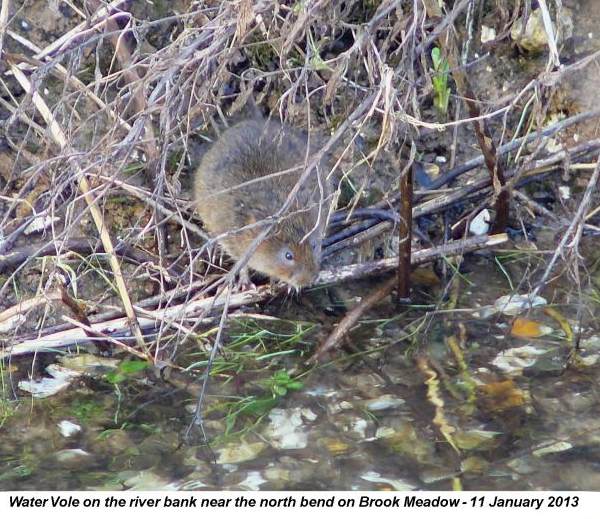
Another
Firecrest
Malcolm Phillips got
some more very good photos of a Firecrest on Brook
Meadow this afternoon, this time from the Lumley Path
bridge over the Lumley Stream.
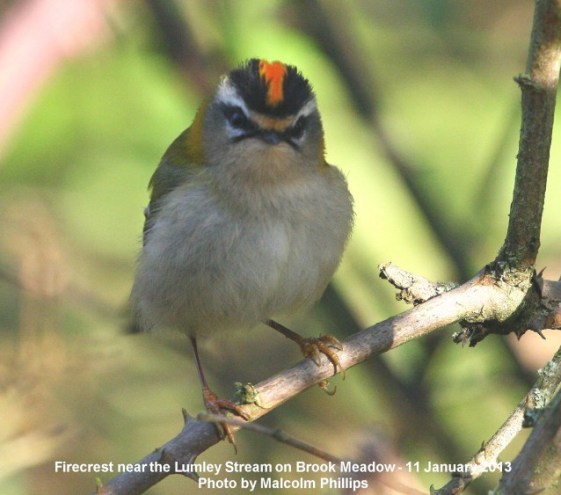
This could possibly
have been the same Firecrest that Malcolm photographed
in the north west corner of the meadow on Jan 4,
though it is impossible to tell from the photo. This
was an exciting sighting and I encourage everyone to
go looking for it. Here is another photo from Malcolm
showing a very penetrating gaze from the Firecrest.

Early
blossom
Roger Mills sent me
this photo of an early spring blossom flower that he
found yesterday on a large red leaved tree by Lumley
Gate. My guess is that it is a Prunus, possibly Cherry
Plum which does flower early, though that does not
have red leaves. I will try to find the tree over the
weekend to confirm.

THURSDAY
JANUARY 10 - 2013
LOCAL
NEWS
Goldcrests
Malcolm Phillips went
round Brook Meadow early this morning. He saw just the
usual birds until he got to the bridge over Lumley
stream where a pair of Goldcrests were playing around.
Are Goldcrests particularly abundant this winter?
Malcolm managed to get one good photo.
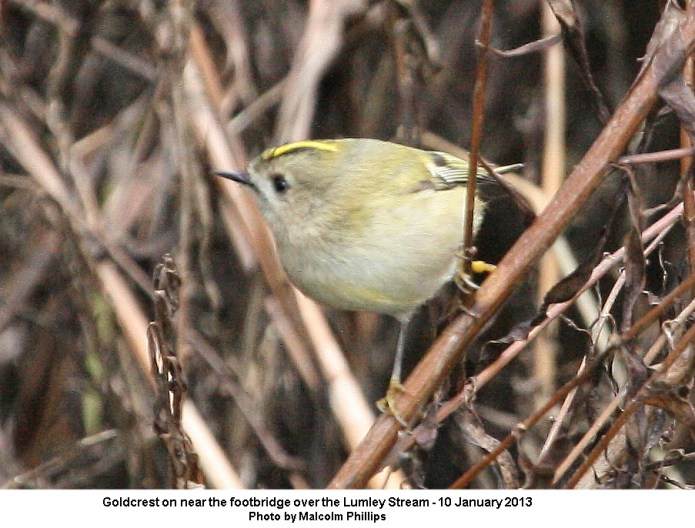
Little
Grebes
Malcolm walked down by
Peter Pond where he saw two Little Grebes fishing. He
got this rather fine image of one of them in winter
plumage with its breeding gape spot already starting
to show.

Kingfisher
Ros Norton walked down
to Thorney Great Deeps today and saw the regular
Kingfisher fly into south west corner of the Deeps.
However, Ros did not see the Dartford Warbler or the
Stonechat that have been in that area recently, though
she was looking out for them today and also a couple
of days ago between the deeps.
WEDNESDAY
JANUARY 9 - 2013
EMSWORTH
HARBOUR
I got to Nore Barn at
11:00 with the tide still fairly high though the
stream was gradually emptying. The Spotted Redshank
was already present feeding on the edges of the
stream with a Greenshank.
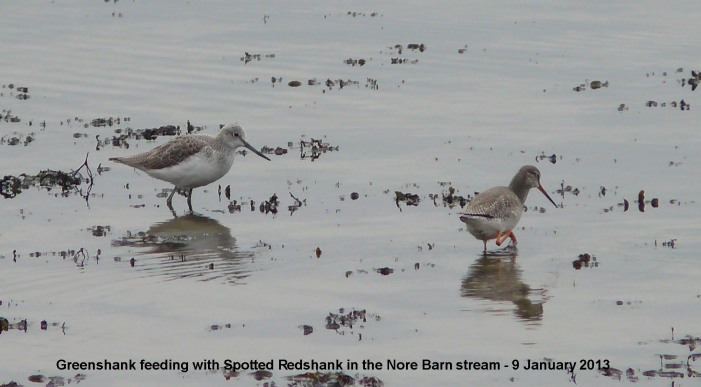
Nothing else in the
stream but for two Mute Swan cygnets. There was a
flock of some 86 Brent Geese on the water
creating a wonderful soundscape of gentle 'kerunking'
calls.
I cycled back along
Western Parade and round the millpond seawall where I
found yet more Brent Geese scattered over the emerging
mudflats, but very few other birds; even the Wigeon
and Teal appear to have disappeared along with the
waders.
There was little else
to see from the marina seawall apart from a scattering
of Redshank and a small group of 5 Black-tailed
Godwits, the first I have seen for a while. None was
colour-ringed.
THORNEY
ISLAND
I cycled down to the
western track to Great Deeps examining the posts and
Gorse bushes hoping or the Dartford Warbler
that was reported as still showing well in this area
yesterday by Barry Collins. I did not see any sign of
it, or of the Stonechat that is said to be in the
area. I also listened in vain for any pinging by
Bearded Tits that Barry reported yesterday on Little
Deeps. In fact, I saw very little of note apart from
several small flocks of Brent Geese flying over the
seawall onto the Eames Farm field from the harbour. A
Cormorant was fishing quietly in the canal, taking no
notice of me as I passed by on my bike.
B+YB
GODWIT QUERY
Pete Potts asked for
my photo of colour-ringed Black-tailed Godwit B+YB
which I saw at Nore Barn on 25 Sept 12. He says the
last time it was seen for sure was 12 Feb 2000 but
there are two possible sightings for 2003 and
2005.
I was not entirely
sure at the time about the colour-ringed combination
on this godwit and the photo was not conclusive. My
notes indicated the Godwit was feeding on the edge of
the saltmarshes west of the Nore Barn stream. It had a
red marker on the left 'ankle' indicating a Farlington
bird and small rings indicating an older ringing. The
upper ring on the left leg was very dark, probably
blue. The upper ring on the left leg stood out clearly
as yellow, but the lower ring was dark, again probably
blue. B//R+YB was my best estimate, which was new for
Emsworth.

TUESDAY
JANUARY 8 - 2013
BRENT
GOOSE RACES
Peter Milinets-Raby
was in Southsea yesterday (Jan 7) doing his usual
Brent Geese survey and got photos of three races of
Brent Goose. Peter's excellent images give us a good
chance to examine the main differences between these
handsome birds.
Dark-bellied
Brent Goose -
Branta bernicla (nominate race) which we are
all familiar with as they winter in their thousands in
local harbours. They breed in Western Siberia and
migrate through The Baltic to winter in NW Europe.
They have a greyish belly, but this varies greatly and
can be often be difficult to separate from the
Pale-bellied.
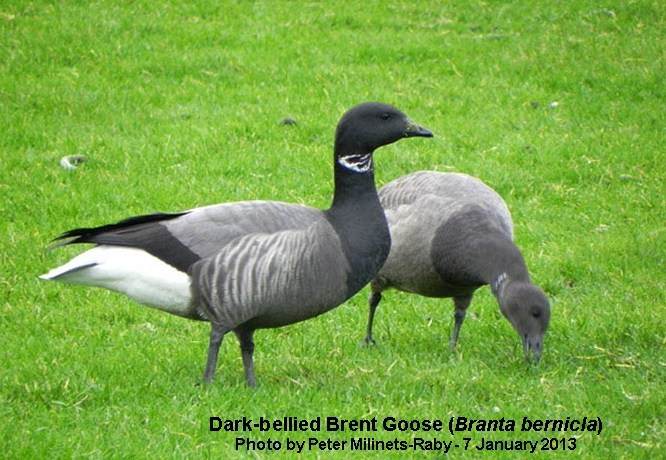
Pale-bellied
Brent Goose -
Branta bernicla ssp hrota. These breed in
Greenland and NW Canada and migrate mainly to Ireland
via Iceland. A few usually get down to the South of
England. They have much paler bellies than the
Dark-bellied with a clear contrast with the black
breast. The bird in the centre of the photo is shown
feeding with some Dark-bellied birds.
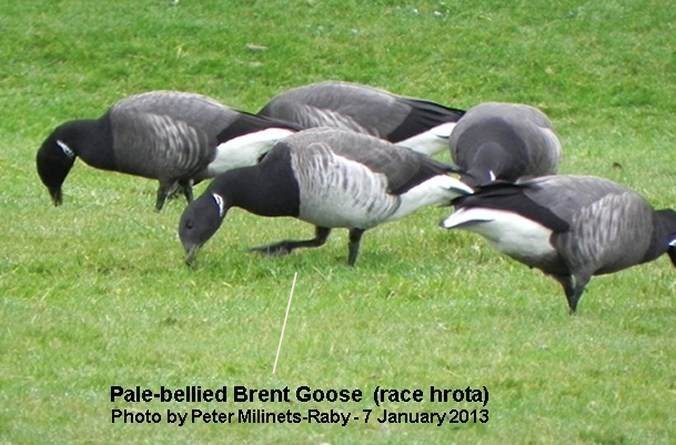
Black Brant -
Branta bernicla ssp nigricans. This is the most
rare of the three races that we see in Southern
England, though one or two do frequently turn up in
flocks of dark-bellied birds. It breeds in Eastern
Siberia, Alaska and NW Canada and so has a long way to
come, though it is thought they summer with the
dark-bellied Brents and migrate with them. The Black
Brant on the left in the photo has a strong contrast
between the white flanks and the dark belly and has a
much wider white neck band than the other two sub
species, often merging at the front. The other two
birds in the photo are regular Dark-bellied birds.

EMSWORTH
HARBOUR
I cycled over to Nore
Barn by 10:30 hoping to catch the Spotted Redshank as
the tide fell, but I think I was a bit too late as the
tide was already well out. Also, the stream had just
been cleared of birds by two boisterous dogs.
Brent
Geese
So I cut my loses and
walked east along Western Parade admiring the Brent
Geese scattered around the mudflats as I went. There
was a particularly dense gathering of Brents on the
mudflats to the west of the Emsworth Sailing Club
building. I would estimate the total in the harbour at
around 500. Here are a few I digiscoped on the
mudflat.

Following the news
from Peter Milinets-Raby I checked a good few of the
Brent Geese, but did not see any Pale-bellied or
Brant. However, I did find four small families of
Brent Geese with 2, 2, 2 and 1 juveniles which is one
more than I have previously seen in the Nore Barn
area. Another one Brent family with one juvenile was
in the main channel on the eastern harbour.
Other
birds
From the millpond
seawall I could see 32 Lapwing roosting on one
of the seaweed covered islands and just 4 Gadwall
in the channel.
One adult Great
Black-backed Gull was snoozing on the mudflats,
probably one of the pair that nested on Slipper
Millpond last spring and which have remained in the
local area ever since. The juveniles appear to have
gone.
The regular Little
Egret was feeding in the low water channel near
the quay with its reflection showing in the water.
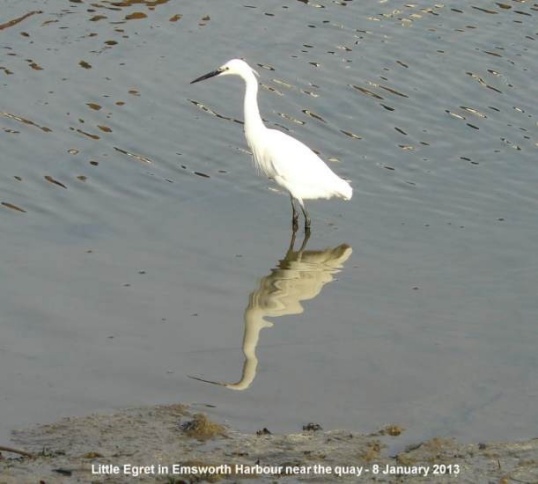
BROOK
MEADOW
Water
Vole
Malcolm Phillips got
to see the Water Vole again by the north bridge. This
seems to be the only one active at present. Malcolm
got this nice image of it before it swam off heading
south.
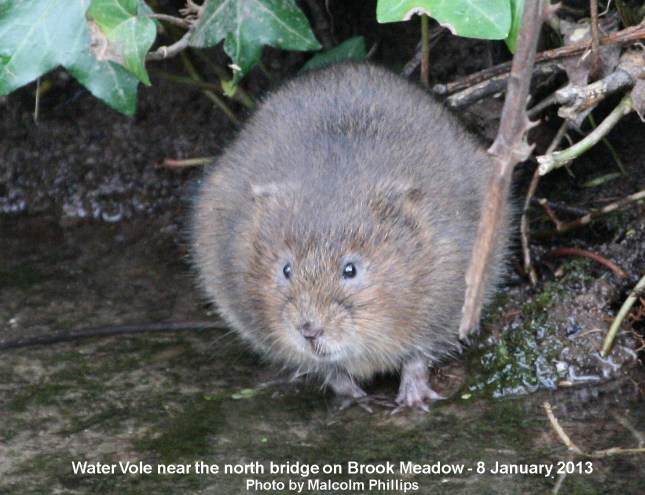
Bird
song
I spent a couple of
hours this morning and this afternoon up dating the
three signcases with new photos. During this time I
heard six songsters all going strong, Robin, Dunnock,
Great Tit, Song Thrush, Collared Dove and Woodpigeon.
Malcolm Phillips got
this fine image of a Song Thrush while he was on the
meadow today. It could have been the same one that I
heard singing.
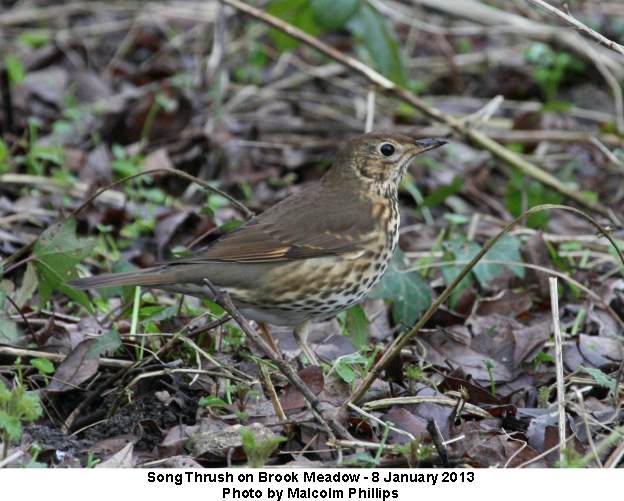
Winter
flowers
I thought all the
Hogweed plants on Brook Meadow had succumbed to the
bad weather. However, this morning I noticed a single
plant with withered leaves, but with a complete flower
head at the foot of the steps leading down to the
meadow from the north bridge.
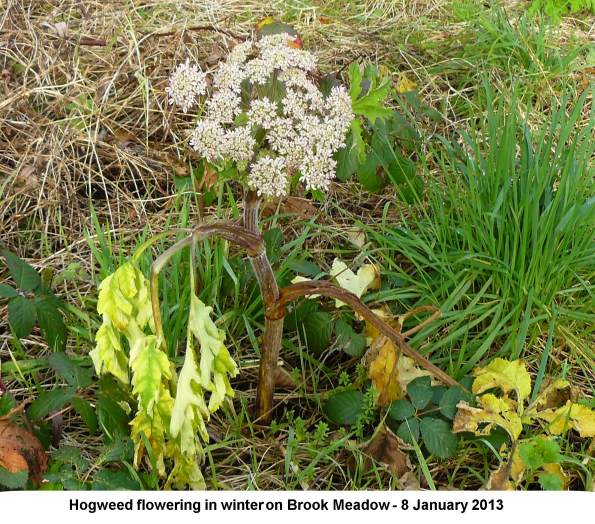
Ralph's
winter flowers
Ralph Hollins reports
the following plants seen in flower in the past
week:-
Creeping Buttercup,
Lesser Celandine, Charlock, Hedge Mustard, Shepherd's
Purse, Sweet Violet, Herb Robert, Gorse, Common
Nettle, Small Nettle, Ivy, Hazel, Grey Alder, Dog's
Mercury, Sun Spurge, Cow Parsley, Hogweed, Wild
Carrot, Ivy Leaved Toadflax, Common Field Speedwell,
Red Deadnettle, White Deadnettle, Water Forget-me-not
(single last flower!), Garden Forget-me-not, Japanese
Honeysuckle, Oxford Ragwort, Groundsel, Ox-eye Daisy,
Daisy, Winter Heliotrope, Scented Mayweed, Scentless
Mayweed, Smooth Hawksbeard, Smooth Sowthistle,
Butcher's Broom (35 Species)
SUNDAY
JANUARY 6 - 2013
Dartford
Warbler
Today Sid Davies saw
what he calls 'the now locally famous' Dartford
Warbler on the west side of Thorney about two thirds
along the track, between the two deeps. Sid had a
marvellous view of a bird which seems to have
befriended a Stonechat which is a good indication as
to its location. The Stonechat typically bobs up and
down between the grass and the posts.
Winter
flowers
During this morning's
work session on Brook Meadow, Lesley Harris pointed
out some flowering Primroses near the path
through Palmer's Road Copse. These are the first I
have seen this year. I looked for Snowdrops in the
usual areas around the meadow, but there was no sign
of any.
Black-tailed
Godwits
There were no
Black-tailed Godwits in Emsworth Harbour in the past
week. They do often move away from the harbours and
onto inland fields during wet weather to feast on
worms brought to the surface by the rains. Andrew
House reported that 800 were on the North Fields at
Pagham Harbour on Jan 5 and Jon Winder counted 229 at
Amberley Wild Brooks on the same day. These sightings
probably account for most of our local birds. I gather
also some 4,000 have been seen in the Avon Valley.
SATURDAY
JANUARY 5 - 2013
BROOK
MEADOW
Still
no Firecrest
I went over to the
meadow this morning to have another look for the
Firecrest in the north west corner. Malcolm Phillips
turned up and we looked together, but we did not see
it. There were lots of other birds in the area,
including Robin, Dunnock, Blackbird, Wren, Blue Tit
and Great Tit, but the Firecrest must have moved on.
House
Sparrows galore
However, Malcolm and I
did enjoy a fine flock of some 12 House Sparrows
chattering and busying themselves in the large patch
of Brambles. They appear to move between Brook Meadow
gardens to the west. Malcolm got the following nice
photos of male and female House Sparrows.
Male House
Sparrow with dark bill, white cheeks, brown nape and
wings, black bib and grey crown
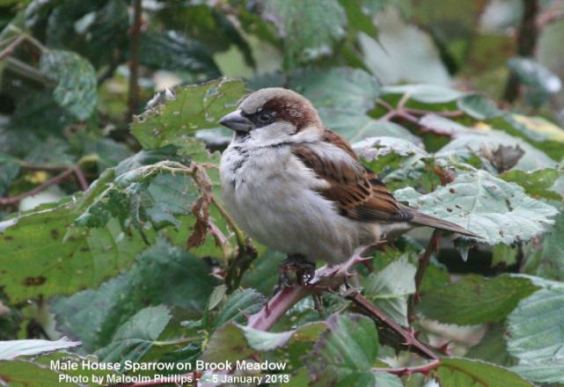
Female House Sparrow
overall is much paler with a yellowish bill and a pale
band behind the eye.
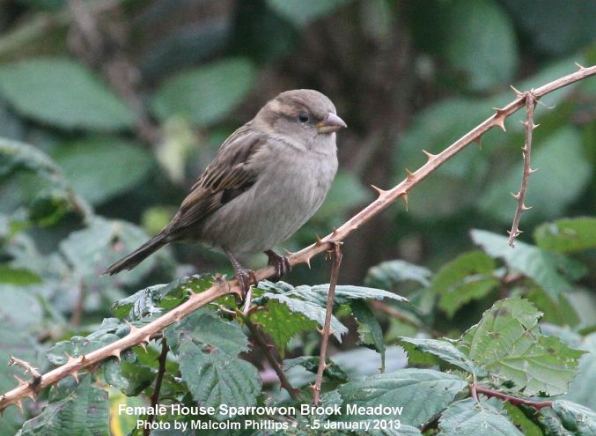
Water
Vole
Malcolm stayed for
about an hour after I left for home and it was worth
it as he saw and got photos of the Water Vole that has
been seen several times just recently north of the
north bridge. Malcolm watched it for about 10 mins as
it slowly worked its way up the river to where the
water comes from the outfall. Here is Malcolm's photo
- the first Water Vole photo of 2013.
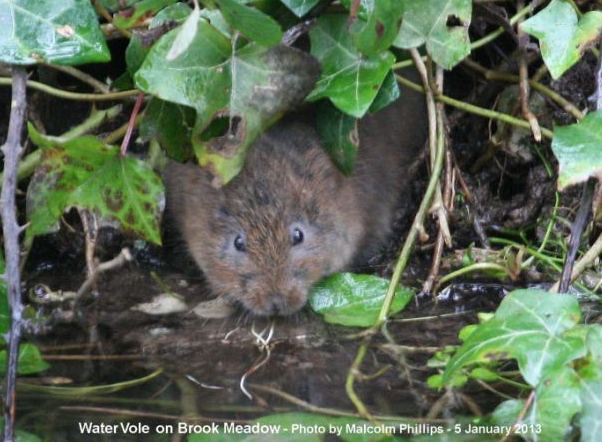
Bird
song
A Song Thrush was
singing strongly in Palmer's Road Copse for the first
time this winter period, just north of the south
bridge. This is in addition to the other new songsters
over the past week, Dunnock, Great Tit and Blackbird.
Winter
flowers
Three flowers of
Creeping Buttercup were open on the Bridge Road
Wayside near the stream, which take my personal
January list to 18 species.
FRIDAY
JANUARY 4 - 2013
BROOK
MEADOW
No
Firecrest
I went over to the
meadow twice this morning to look for the Firecrest
that Malcolm Phillips saw in the north west corner
brambles yesterday. There was a good deal of bird
activity in this large patch of brambles, including
Blue Tit, Great Tit, Wren, Dunnock, Robin, and House
Sparrow, but no sign of the Firecrest. Malcolm also
went looking for the Firecrest, but only found what
looks like a Goldcrest investigating a tree trunk for
insects.

Bird
song
While I was on Brook
Meadow I heard at least two Great Tits singing
their 'teacher' song for the first time. A man who was
passing told me he had heard a Blackbird
singing on the east side of the north meadow. That
would be another first for this winter. I had a listen
but did not hear it.
Scentless
Mayweed
I found several plants
of Scentless Mayweed still in full flower on the new
Emsworth Railway Station wayside. Despite its name
this plant does not flower in May but from July
onwards and is not unusual in winter. The name is
derived from the Old English word for maiden and
refers to its use in the treatment of female
disorders. But, true to its name, the flowers are not
scented, unlike the very similar Scented Mayweed,
which also grows on the Railway Wayside, but is not
currently in flower. Sea Mayweed is very similar to
Scentless Mayweed, but it grows by the sea, on shingle
and on muddy shores. One needs to examine the fruits
to distinguish them conclusively (see Rose, new
Edition).
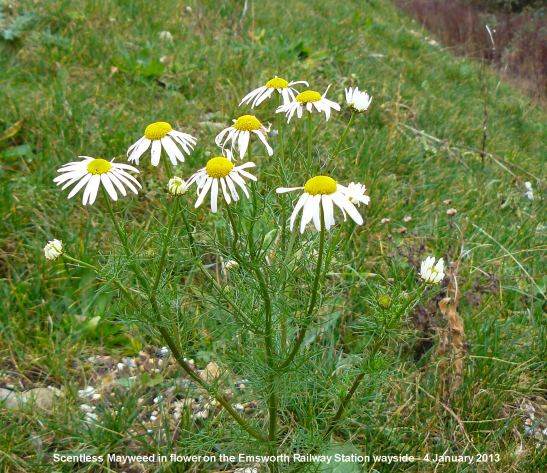
OTHER
NEWS
Blackcaps
in garden
Patrick Murphy had
several visits this morning from a male Blackcap
eyeing up the tasty fat balls on offer. Another bird
that came looking for food in Patrick's garden was a
Grey Heron, but it found the pond well netted and the
tasty fish out of reach. It will try again.
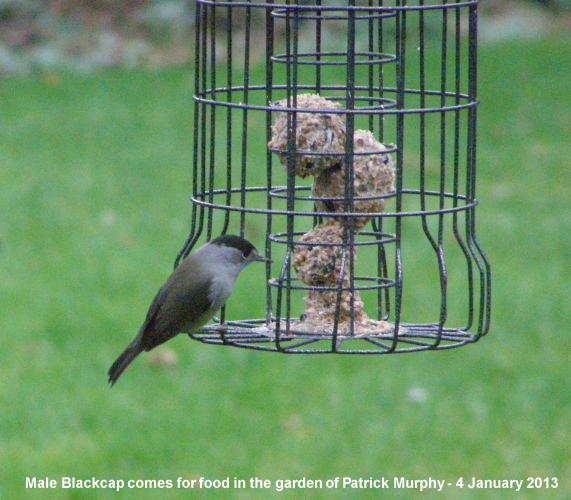
Caroline French also
has Blackcaps in her North Emsworth garden. She has a
regular male Blackcap feeding on both apple and fat
balls, and a couple of days ago there was a female
feeding on a different fat ball feeder. They were
feeding only about 2 metres apart, but there was no
aggression between them. Why should there be? Food for
all.
Peter's
New Year's birds
Peter Milinets-Raby
had a fine time compiling his New Year's Day list of
birds. Here is his photo of a Sanderling taken at
Sandy Point on Hayling Island. What a bright bird,
caught in the winter sunshine.
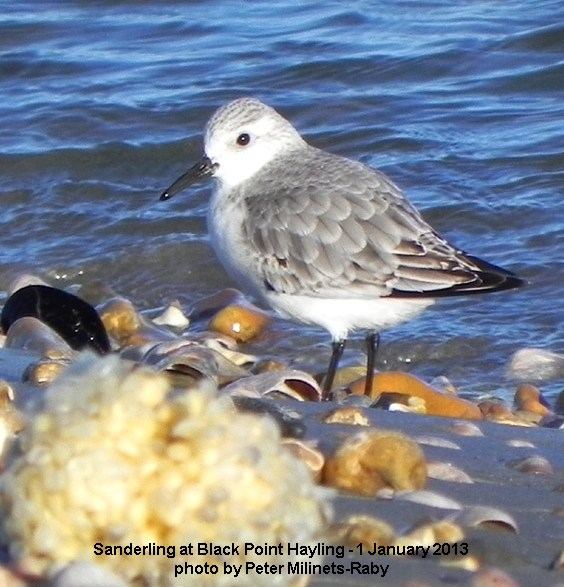
Peter has also
produced one of his videos as he says, "to capture the
thrill of year listing on New Year's Day and the
unparalleled joy of adding a number of birds into that
oh so important little red note book (tongue firmly in
cheek)." Here is the YouTube link to the video . . .
http://youtu.be/i27qeRgiF0U
Look out for the interesting entries in his red book.
THURSDAY
JANUARY 3 - 2013
BROOK
MEADOW
First
Firecrest
Pride of place in
today's news undoubtedly goes to Malcolm Phillips who
saw and photographed the first ever Firecrest to be
recorded on Brook Meadow. Malcolm saw it on brambles
in the far north west corner of the meadow.
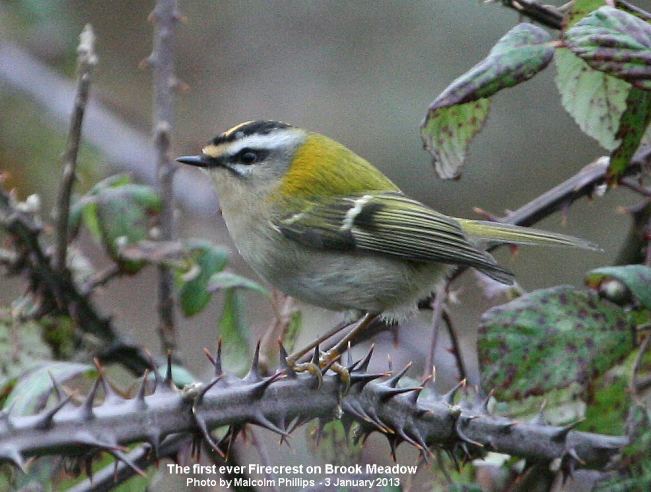
The photo shows nicely
the white supercilium, clashing with the dusky eye
stripe and grey cheeks. The crest does not show too
well, but the yellow hue suggests the bird may be
female. The male would have more of an orange crown
stripe.
Firecrest is a fairly
scarce but increasing resident and winter visitor to
the South of England, seen in winter mostly near the
coast. The last one we had in Emsworth was last year
from Feb 10 to Feb 23 in Nore Barn Woods. If this one
keeps to the same pattern then it might be around for
a while and worth looking for.
First
Water Vole of 2013
Terry Lifton has the
honour of seeing the first Water Vole of the year; he
got a good view of one eating Ivy leaves near the
north bridge on Brook Meadow. This, in fact, must be
the earliest record we have for a Water Vole on Brook
Meadow. It could be the same animal that Jane and Andy
Brook saw on Dec 26.
EMSWORTH
HARBOUR
11:00 - 12:00 - I had
a look at the eastern harbour this morning about 3-4
hours to high water. Viewing the eastern harbour from
the marina seawall there were very few birds in the
main harbour. Certainly no sign of any Black-tailed
Godwits. I counted 18 Gadwall in the main
channel, an increase on the 8 that I saw there
yesterday. There were also some Teal but no other
ducks. Brent Geese were less numerous than yesterday.
Are they also moving inland to feed as they did last
year?
I walked as far as
Little Deeps where I found some Goldfinches
feeding on the Lesser Burdock seeds on the Wickor
Bank. Just Tufted Duck and Teal were on the Little
Deeps.
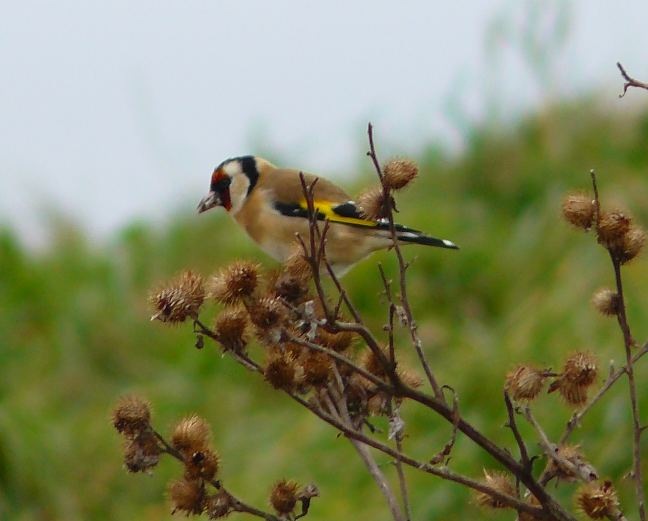
OTHER
NEWS
Bird
song
I heard a Dunnock
singing from the bushes in Bridge Road car park. This
was the first full Dunnock song I have heard this
winter.
Winter
flowers
Plants in flower I saw
during this morning's walk to Thorney Little Deeps
included Hedge Mustard on the marina seawall, Greater
Periwinkle on the east side of Slipper Millpond and
Sweet Violets on the path behind Lillywhite's Garage.
These take my personal January total to 14. Ralph
Hollins found 27 plants in flower on New Year's Day
around the Havant area. For my monthly winter lists go
to . . . http://www.emsworthwildlife.hampshire.org.uk/plant-list-monthly.htm
Ems
Valley
On a walk from Lumley
to Westbourne walk, Terry Lifton saw a Green
Sandpiper and a couple of Snipe in a
flooded field north of the A27. I regularly used to
see Green Sandpiper and Snipe along the River Ems
between Emsworth and Westbourne in the 1990s, so it is
good to hear they still frequent the area.
Great
Northern Diver
At about 3pm today Ros
Norton had a good view of a Great Northern Diver that
was diving in Langstone Harbour between The Kench and
Hayling Ferry and visible from both places. This bird
has been reported on Hoslist for the past week and
might be around for some time yet. Here is a photo
taken by Tony Wootton of what could possibly be the
same Great Northern Diver at the same place 2 years
ago.

WEDNESDAY
JANUARY 2 - 2013
EMSWORTH
HARBOUR
Emsworth
Harbour (east)
10:00 - 11:00 Tide
rising to high water at 14:00.
I started on the
millpond seawall from where I could see the eastern
harbour filling quickly as the tide came in.
The most interesting
birds were the 8 Gadwall in the main channel,
the first of the winter in Emsworth Harbour. I only
recorded two last year in the Nore Barn area, but in
2011 we had a record 72 in the eastern harbour on 16
January.
Other birds in the
eastern harbour included c200 Brent Geese and 15
Shelduck plus the usual waders, such as Grey
Plover, Redshank, Turnstone, but with the notable
exception of Black-tailed Godwits. An adult Great
Black-backed Gull was on the mudflats, probably the
same bird that now regularly comes to Slipper
Millpond.
Two Little Grebes were
fishing in the main channel and just one male
Red-breasted Merganser. I was surprised not to se
others, but this one was definitely alone. Maybe it
will come onto the millpond?
Standing on the
seawall east of the Emsworth Sailing Club building I
watched a Little Egret feeding in the outfall from the
millpond; this is probably the bird that feeds on the
low water millpond and sometimes ventures up the
Westbrook Stream to perch on our garden fence. An
unringed Greenshank was feeding in the channel.
A few Dunlin were
scattered around the mudflats to the east of the
sailing club, which reminded me I had not seen any
Ringed Plover in the harbour this winter. I could just
make out a flock of around 150 Knot on the
Thorney shore near the Great Deeps and a flock of
about 80 Lapwing on the edge of the
saltmarshes.
Emsworth
Harbour (west)
11:00 - 11:00 - The
dominant birds on the western mudflats were Brent
Geese and Wigeon. I spotted just 2 Pintail, a
male and female pair in one of the small channels.
I got to Nore Barn at
about 11:15 by which time the regular Spotted
Redshank was already present, waiting on the edge
of the lower stream as it its custom.

The Spotted Redshank
then ran quickly up the stream where it continued to
feed for the next hour or so when I got this
digiscoped image. Sorry for yet another photo, but I
have been deprived for the past two weeks.
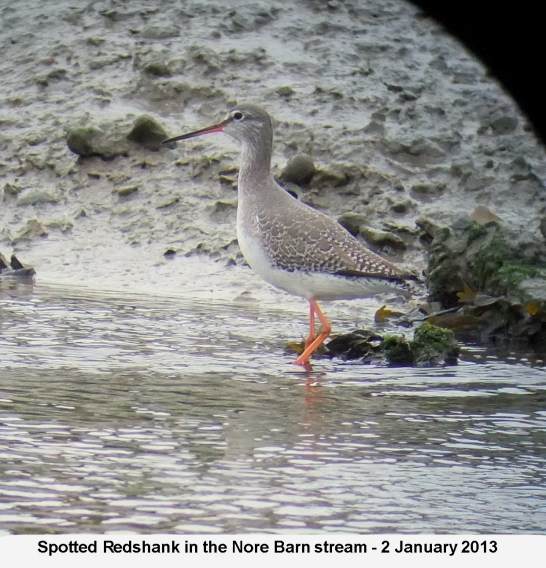
The Greenshank
arrived a little later, though it spent much to
the time snoozing on the edge of the lower stream as
the tide pushed in.
I counted another
42 Shelduck at Nore Barn making a grand total
of 57 for the harbour as a whole. There were plenty of
Wigeon and Teal in the Nore Barn Creek
There was no sign of
any Black-tailed Godwits anywhere in the either
harbour. Clearly, they must have moved onto the
flooded fields to feast on worms. They have frequently
done this in past winters during very wet periods.
Ralph Hollins reported a couple of probable record
counts made on Dec 27 with 1070 at Pagham Harbour
North Walls and 4000 in the Hampshire Avon valley at
Bisterne. So, that's where they have gone.
Ralph Hollins arrived
at about 11:30 and was pleased to add Spotted Redshank
and Greenshank to his 2013 bird list. Ralph had a
scare when he discovered the eyepiece was missing from
his scope. We both searched the stony shore and I
finally found it near the boats, much to Ralph's
relief.
Insects
A couple of Bluebottle
flies were feeding on the few remaining open Ivy
flowers on the hedge at the end of Western Parade
close to Nore Barn. No sign of any other insects,
though it was fairly chilly. Maybe, the Bumblebees
will return with warmer weather?
TUESDAY
JANUARY 1 2013
NEW
YEAR'S DAY WALK
Heather Mills reported
on this morning's traditional Hampshire Wildlife Trust
New Year's Day walk.
Go to . . .
hwg-walk-reports-2013
COLLARED
DOVES
In response to the BTO
report that Collared Doves were in decline, Mary and
Keith Marriot sent me a photo of some 22 Collared
Doves that they had in their Westbourne garden.
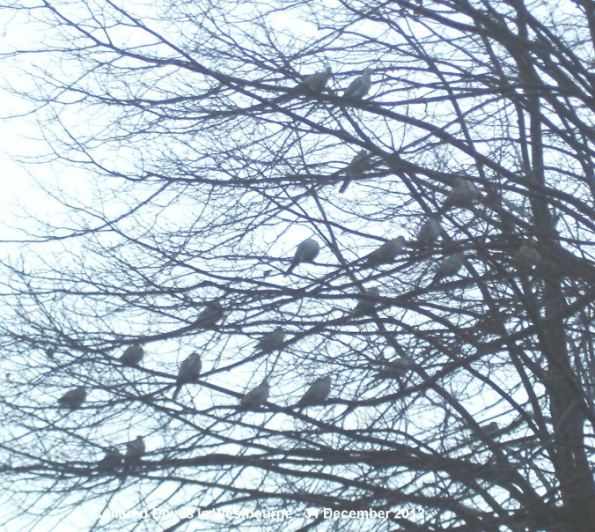
Interestingly, I have
also been getting an increase in Collared Doves in my
Emsworth garden over the past week or so. 10 Collared
Doves were on the grass today feeding on the seeds and
chopped peanuts, which is the most I have had since
this time last year. However, the trend for Collared
Doves in my garden shows a sharp decline in the last 5
years.
The BTO Breeding Birds
Survey also shows a general decline in Collared Dove
records since about 2005 as shown in this chart. The
red line is the smoothed trend curve.
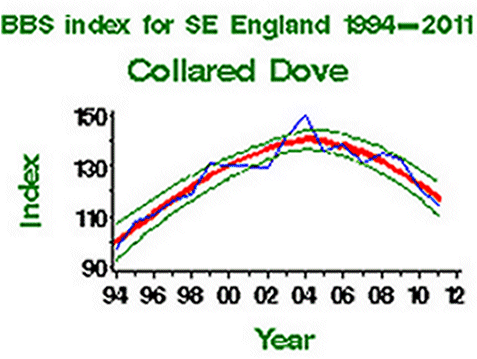
The BTO Garden
BirdWatch records show a similar downward trend over
the past 7 years. http://blx1.bto.org/gbw-dailyresults/results/gbwr271-7.html
For
earlier observations go to . . . December
1-30